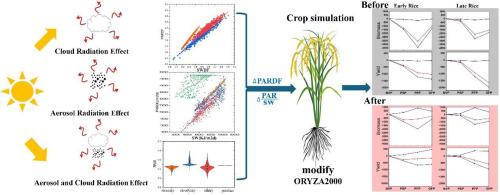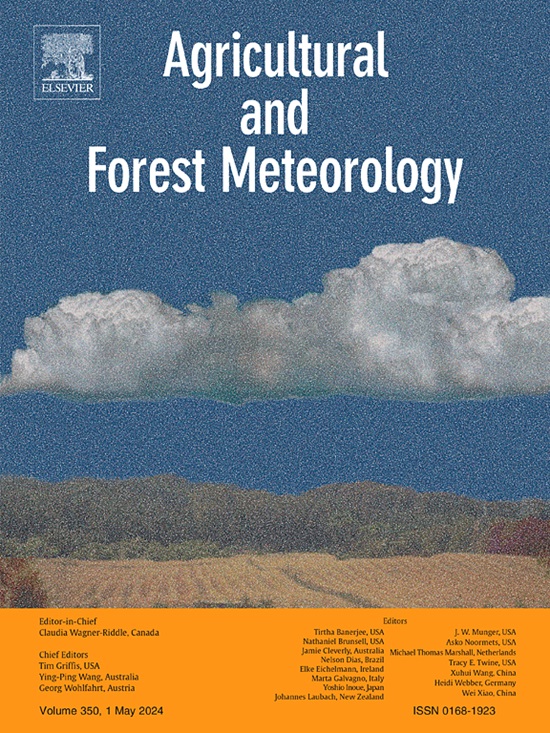Quantifying the effects of aerosols and cloud radiative effect on rice growth and yield
IF 5.6
1区 农林科学
Q1 AGRONOMY
引用次数: 0
Abstract
Radiative Effect (RE) caused by aerosols and clouds significantly impacts crop growth by altering both the spectral distribution and the amount of diffuse light reaching the crop canopy. Traditional crop models often fail to account for these variations in photosynthetically active radiation (PAR), leading to biases in crop growth simulations. To address this, we modified the ORYZA2000 crop model to improve the accuracy of radiation assessment. Using the RTM LibRadtran, we evaluated the effects of aerosol and cloud RE on rice growth and yield, utilizing data from Jiangxi Province, China (2011–2016). The results indicated that aerosols scatter PAR more effectively, with a scatter intensity 1.42 times greater than that of Shortwave Radiation (SW). Clouds increased the ratio of PAR in SW (FPAR) from 0.437 ± 0.01 to 0.448 ± 0.01. Ignoring PAR assessment in the crop model led to a 25.55 % overestimation of rice yield. When accounting for the diffuse fraction of PAR (PARDF) and FPAR, aerosol direct radiative effect (ADRE) increased rice yield by 18.58 %, cloud radiative effect (CRE) decreased yields by 16.13 %, and combined aerosol and cloud radiative effect (ACRE) resulted in a 31.71 % decrease in yields. Although aerosols alone increased yield by enhancing diffuse PAR, the combined effect of clouds and aerosols resulted in a lower overall PAR and caused a greater reduction in yield than clouds alone. Early rice exhibited more sensitivity to RE, allocating more biomass to the panicle in the early stages, while late rice increased leaf biomass during late stages under RE. This study underscores the importance of accurate PAR estimation in crop modeling and highlights the need to integrate the diverse impacts of RE into future crop yield predictions.


气溶胶和云层造成的辐射效应(RE)会改变到达作物冠层的光谱分布和漫射光量,从而对作物生长产生重大影响。传统的作物模型通常无法考虑光合有效辐射(PAR)的这些变化,从而导致作物生长模拟的偏差。为此,我们修改了 ORYZA2000 农作物模型,以提高辐射评估的准确性。利用 RTM LibRadtran,我们利用中国江西省(2011-2016 年)的数据评估了气溶胶和云 RE 对水稻生长和产量的影响。结果表明,气溶胶能更有效地散射 PAR,其散射强度是短波辐射(SW)的 1.42 倍。云使 PAR 与 SW 的比率(FPAR)从 0.437 ± 0.01 增加到 0.448 ± 0.01。在作物模型中忽略 PAR 评估会导致水稻产量高估 25.55%。当考虑 PAR 的漫射部分(PARDF)和 FPAR 时,气溶胶直接辐射效应(ADRE)使水稻增产 18.58%,云辐射效应(CRE)使水稻减产 16.13%,气溶胶和云辐射效应(ACRE)导致水稻减产 31.71%。虽然气溶胶本身通过提高漫射PAR增加了产量,但云层和气溶胶的综合效应导致总体PAR降低,造成的减产幅度大于云层本身。早稻对可再生能源更敏感,在早期阶段将更多生物量分配给圆锥花序,而晚稻则在可再生能源的后期阶段增加叶片生物量。这项研究强调了在作物建模中准确估计PAR的重要性,并突出了将RE的各种影响纳入未来作物产量预测的必要性。
本文章由计算机程序翻译,如有差异,请以英文原文为准。
求助全文
约1分钟内获得全文
求助全文
来源期刊
CiteScore
10.30
自引率
9.70%
发文量
415
审稿时长
69 days
期刊介绍:
Agricultural and Forest Meteorology is an international journal for the publication of original articles and reviews on the inter-relationship between meteorology, agriculture, forestry, and natural ecosystems. Emphasis is on basic and applied scientific research relevant to practical problems in the field of plant and soil sciences, ecology and biogeochemistry as affected by weather as well as climate variability and change. Theoretical models should be tested against experimental data. Articles must appeal to an international audience. Special issues devoted to single topics are also published.
Typical topics include canopy micrometeorology (e.g. canopy radiation transfer, turbulence near the ground, evapotranspiration, energy balance, fluxes of trace gases), micrometeorological instrumentation (e.g., sensors for trace gases, flux measurement instruments, radiation measurement techniques), aerobiology (e.g. the dispersion of pollen, spores, insects and pesticides), biometeorology (e.g. the effect of weather and climate on plant distribution, crop yield, water-use efficiency, and plant phenology), forest-fire/weather interactions, and feedbacks from vegetation to weather and the climate system.

 求助内容:
求助内容: 应助结果提醒方式:
应助结果提醒方式:


